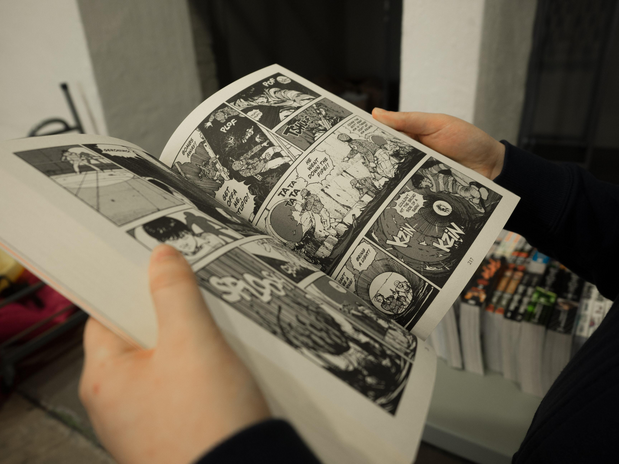When was the last time you skipped reading the front page of your daily newspaper and went straight for that section which displayed your favorite comic strip? For me, it was this morning. I have to admit that the words ‘to be continued’ have always seemed to crush me ever since I was a kid. Comics like Peanuts, Calvin n Hobbes, Champak and so on undoubtedly constituted a massive part of my childhood and guess what- even my adulthood. Unless you have been living under a rock, you may have come across these comics at some point in your life too.
Human beings have been using images and graphics to convey messages or tell stories since time immemorial. Children’s fascination with picture books can only be explained as the power of graphics. While starting middle school, you must’ve been startled by the enormous amount of continuous text without any colorful pictures to break the monotony. Soon we found solace in Marvel and DC Comics which expanded our fascination for graphic narratives.
Between comics, Manga and graphic novels, we see a huge industry coming up that isn’t a one-time hit but is here for the long run. Graphic narratives offer a broad range of techniques to bring out a character’s subjectivity. Facial expressions, gestures, body language and gaze combined with the verbal content offer a solid competition to the existing non-graphic narratives. A decade ago, this idea may have looked grim but today it is one of the fastest-growing industries in publishing. Comic books previously had the reputation of being ‘immature’ or ‘vulgar’ compared to other literary texts. This may have to do with the fact that they were cheap or readily available to the general public. This provided a segue for the emergence of graphic novels that managed to evade such labels, perhaps because of their association with the word ‘novel’ and hence literature.
To the untrained eye, comic books and graphic novels may appear similar- they both have dialogue bubbles as well as illustrations. To begin with, graphic novels have longer and heavier narratives than comic books and are often bound by a story arc. They are divided into panels that divide time and space in the storyline. These panels gain their whole meaning with the dynamic interaction of each scene’s visual and verbal content. The use of color, shape and framing of each panel is well thought out and helps to create a layered narrative that is not bound by linear restrictions like narratives in films usually are. It gives the author the much required creative space to challenge the reader’s interpretive choices. One of the best examples of successful graphic narratives is Japanese Manga. Engaging with the readers and inviting them to participate in the story is common in all comics but Manga creators stand clearly undefeated among them.
Manga is the Japanese equivalent of the term ‘American graphic novel.’ Its visual attractiveness comes from the small world details, the complex characters and their emotionally expressive symbolism. The graphic narrative in Manga is brought out so that the readers are mentally transported into the scene and participate in the story as a bystander as it proceeds. They automatically become invested in the climax and, during the process, identify with the characters and their problems.
The popularity of the manga series Death Note is huge and it has managed to transcend even global boundaries because of its iconic characters, complex themes and genius artwork. The storyline itself is an edge-of-the-seat battle of mind games with underlying themes of death and destruction. Tsugumi Ohba does an impressive job of creating the graphic narrative and playing with the psychological complexities and moralities of his characters and the readers. Teamed up with the brilliant author, Takeshi Obata, the illustrator of the manga series, complemented the narrative with his artwork.
I could go on but I think I have sung enough praises about graphic narratives. The elephant in the room is how this affects the popularity of non-graphic novels and the existing industry. To understand it first-hand, I read the graphic adaptation of one of the greatest novels ever written- How to Kill a Mockingbird. I have to admit I was a little sceptical that this would ruin a delicious classic for me. Even though slight changes were made in the verbal narrative to incorporate the illustrations, the adaptation really stayed true to Harper Lee’s words. The soft color palette used for the detailed illustrations was really soothing to the eyes and went perfectly with the verbal narrative. It really was a refreshing experience and I can confirm that the adaptation did not ruin the essence of the original classic. In all honesty, I was hooked to the book, just like when I sat down to read the classic for the first time.
From this little experiment, I may have learned a few things; we should keep an open mind while approaching literature and not label it before actually experiencing it first-hand. A rise in the popularity of graphic novels doesn’t necessarily result in a simultaneous decline of non-graphic ones; they can co-exist together as equally good forms of literature. Graphic novels make use of their illustrations to keep their readers hooked and keep them flipping the pages. On the other hand, a strong verbal narrative can do the job alone too, as history has proved.
At the end of the day, If a book captivates the reader to the extent of being emotionally invested in it, it is more than a job well done.

